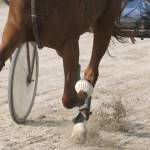Balancing “Energy In” and “Energy Out” for Performance Horses

Regardless of what type of work they are asked to do, horses use a certain amount of energy in training and performance, with more energy consumed in strenuous or long-duration work than in short periods of easy work. Learning more about how energy is used by the horse allows equine nutritionists to make nutritional recommendations for a wide range of equine activities.
Veronique Julliand, a French veterinarian, led a study that analyzed the type of exercise performed and amount of energy expended during training by harnessed trotters and endurance horses. The research team found that training for endurance horses involved outdoor rides at two speeds. Some of the rides were done at 13 kilometers per hour (8 mph) with 70% of the ride at a trot, while others were done at 8 kilometers per hour (5 mph) with 80% of the ride at a walk. The horses were also cantered on a racetrack and spent some time on a walker. The trotters were walked and trotted at varying speeds and also did some interval training.
Energy expenditure for each type of work was calculated using a facemask that measured the exchange of oxygen and carbon dioxide as the horses exercised. The amount of oxygen consumed during different levels of exercise was used to figure total kilocalories, or the amount of oxygen consumed per minute per kilogram of the horse’s body weight. As expected, kilocalorie totals rose as work levels became more intense.
As the study continues, the team will attempt to use the data to formulate applications and develop a software program to help in ration calculation for horses that exercise at different intensities. Eventually, the team’s goal is to provide information about how to feed horses that participate in every equestrian discipline.








